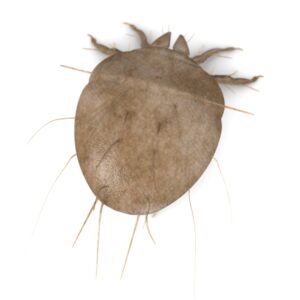September 08, 2021 | Black & Kletz Allergy
If you have been doing yardwork this Summer, you may have noticed a multitude of red swollen itchy hive-like marks that seem like some sort of bug bite all over your body. You may be correct and these bug bites may well be caused by oak mites. Other names for oak mites include oak leaf gall mites, oak tree mites, and itch mites. Oak mites probably originated in Europe but have been in North America since the early 2000’s. They have increased in frequency in the U.S. ever since. They tend to be more of a nuisance in the Summer and Fall. Oak mites are microscopic and contain 8 legs. Since they have 8 legs, they are considered arachnids, like a spider or a tick. They are technically not insects because insects have 6 legs.
Normally, oak mites tend to hide in oak galls. Oak galls are unusual deformities (i.e., swellings) of plant growth comprised of plant tissue commonly on foliage caused by chemicals that regulate plant growth which are produced by insects or arthropods. Oak mites usually feed on midge fly larvae in these oak galls. This year, however, oak mites have also feasted on cicada eggs. The oak mites fall out of oak trees while eating cicada eggs, land on humans, and then bite them. Keep in mind that oak mites can fall out of trees in very large numbers, sometimes more than hundreds of thousands at a time. Oak mites are also carried off by the wind and can spread to other trees in this manner.
As mentioned above, this year in particular, the number of oak mites have increased almost exponentially in certain areas of the U.S. including the Washington DC, Maryland, and Virginia region. This Summer brought the reemergence of the 17-year Brood X cicadas, and as a result, oak mites have come out in full force in the Washington, DC metropolitan area in hopes to thrive on the plentiful cicada eggs. The good news is that once that food source (i.e., cicada eggs) is gone, the numbers of oak mites will diminish greatly.
Since oak mites are microscopic and cannot be seen with the naked eye, the bites are even more frustrating since they appear on the skin almost like magic. The bites can be numerous and overwhelming. In addition to biting exposed skin (e.g., arms, neck, face), oak mites can bite under loose clothing and/or between the hairs on the head.
You may wonder what you can do in order to avoid oak mite bites. Some avoidance measures may include the following:
- Avoid congregating under trees, especially in the Summer and Fall
- Wear protective clothing including hat and gloves when in the woods or under a tree
- Wash clothes and put dryer on medium temperature after being near trees
- Keep house doors and windows closed
- Shower after being outside near trees
The treatment of oak mite bites is pretty basic and involves some common sense remedies. The use of over-the-counter antihistamines (e.g., Benadryl, Claritin, Allegra, Zyrtec) may be beneficial to help with associated itching and swelling. Over-the-counter Hydrocortisone creams may also help the itching as well as reduce the size and duration of the hive-like reactions from the bites. It may also be advantageous to apply a cold compress to the oak mite bites to help prevent swelling, if possible.
The board certified allergy doctors at Black & Kletz Allergy treats both adults and children and will gladly answer any questions you have concerning oak mite and insect bites. Black & Kletz Allergy has 3 offices in the Washington, DC, northern Virginia, and Maryland metropolitan area with locations in Washington, DC, McLean, VA (Tysons Corner, VA), and Manassas, VA. We offer on-site parking at each location and the Washington, DC and McLean offices are also Metro accessible. There is a free shuttle that runs between our McLean office and the Spring Hill metro station on the silver line. If you would like to make an appointment with our allergy specialist, please call us or alternatively, you can click Request an Appointment and we will respond within 24 hours by the next business day. Black & Kletz Allergy has been providing quality allergy, asthma, sinus, and immunological services to the Washington, DC metro area for more than 50 years.













